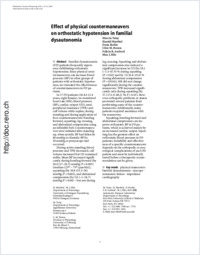Effect of physical countermaneuvers on orthostatic hypotension in familial dysautonomia
- Tutaj, M. Department of Neurology, Jagiellonian University, Krakow, Poland - Autonomic Diseases Laboratory, Department of Neurology, New York University School of Medicine, USA
- Marthol, H. Department of Neurology, University of Erlangen-Nuremberg, Germany - Autonomic Diseases Laboratory, Department of Neurology, New York University School of Medicine, USA
- Berlin, D. Autonomic Diseases Laboratory, Department of Neurology, New York University School of Medicine, USA
- Brown, Clive M. Division of Physiology, University of Fribourg, Switzerland
- Axelrod, F. B. Autonomic Diseases Laboratory, Department of Neurology, New York University School of Medicine, USA
- Hilz, M. J. Department of Neurology, University of Erlangen-Nuremberg, Germany - Autonomic Diseases Laboratory, Department of Neurology, New York University School of Medicine, USA
-
17.08.2005
Published in:
- Journal of Neurology. - 2006, vol. 253, no. 1, p. 65-72
English
Familial dysautonomia (FD) patients frequently experience debilitating orthostatic hypotension. Since physical countermaneuvers can increase blood pressure (BP) in other groups of patients with orthostatic hypotension, we evaluated the effectiveness of countermaneuvers in FD patients.In 17 FD patients (26.4 ± 12.4 years, eight female), we monitored heart rate (HR), blood pressure (BP), cardiac output (CO), total peripheral resistance (TPR) and calf volume while supine, during standing and during application of four countermaneuvers: bending forward, squatting, leg crossing, and abdominal compression using an inflatable belt. Countermaneuvers were initiated after standing up,when systolic BP had fallen by 40mmHg or diastolic BP by 30mmHg or presyncope had occurred.During active standing, blood pressure and TPR decreased, calf volume increased but CO remained stable.Mean BP increased significantly during bending forward (by 20.0 (17 – 28.5) mmHg; P = 0.005) (median (25th– 75th quartile)), squatting (by 50.8 (33.5 – 56) mmHg; P = 0.002), and abdominal compression (by 5.8 (–1 – 34.7) mmHg; P = 0.04) – but not during leg–crossing. Squatting and abdominal compression also induced a significant increase in CO (by 18.1 (–1.3 – 47.9) % during squatting (P = 0.02) and by 7.6 (0.4 – 19.6) % during abdominal compression (P=0.014)). HR did not change significantly during the countermaneuvers. TPR increased significantly only during squatting (by 37.2 (11.8 – 48.2) %; P = 0.01). However, orthopedic problems or ataxia prevented several patients from performing some of the countermaneuvers. Additionally, many patients required assistance with the maneuvers.Squatting, bending forward and abdominal compression can improve orthostatic BP in FD patients, which is achieved mainly by an increased cardiac output. Squatting has the greatest effect on orthostatic blood pressure in FD patients. Suitability and effectiveness of a specific countermaneuver depends on the orthopedic or neurological complications of each FD patient and must be individually tested before a therapeutic recommendation can be given.
- Faculty
- Faculté des sciences et de médecine
- Department
- Département de Médecine
- Language
-
- English
- Classification
- Medicine
- License
-
License undefined
- Identifiers
-
- RERO DOC 5955
- DOI 10.1007/s00415-005-0928-3
- Persistent URL
- https://folia.unifr.ch/unifr/documents/300109
Statistics
Document views: 111
File downloads:
- pdf: 311
